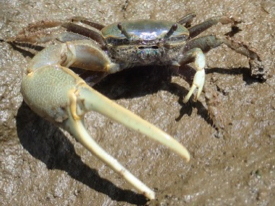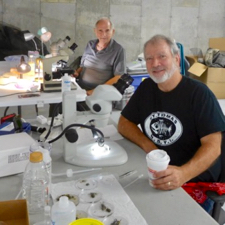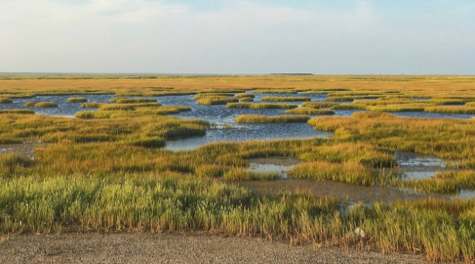Study shows climate change can help crab escape its parasites
Shift to new habitat helps fiddler crabs leave some troubles behind
As Earth warms, species around the world—Adélie penguins, earthworms, gray snapper, pin oaks—are shifting into habitats once too cold for them. One such “climate migrant” is the Atlantic mud fiddler crab Minuca pugnax. Historically found only as far north as Cape Cod, this saltmarsh dweller has now been seen in southern Maine, 75 miles farther poleward.
 A key question for ecologists is how the arrival of climate migrants might impact the native ecosystem, and vice versa. A recent study in Marine Ecology Progress Series uses Minuca’s expansion to ask another, related question: can climate change help you escape your parasites?
A key question for ecologists is how the arrival of climate migrants might impact the native ecosystem, and vice versa. A recent study in Marine Ecology Progress Series uses Minuca’s expansion to ask another, related question: can climate change help you escape your parasites?
Lead author Dr. David Johnson, a marine ecologist at William & Mary’s Virginia Institute of Marine Science, says, “You see this with invasive species when they are carried from one continent, say Europe, to a new one, say North America. They often leave their enemies—predators, competitors, and parasites—behind. We wanted to know if a species that colonizes a new habitat that’s near its old one could also escape its enemies, in this case, its parasites.”
 Johnson and his co-authors discovered the answer is a clear yes. He was joined on the paper by VIMS colleagues Dr. Jeff Shields and Danielle Doucette, along with Dr. Richard Heard of the University of Southern Mississippi’s Gulf Coast Research Laboratory.
Johnson and his co-authors discovered the answer is a clear yes. He was joined on the paper by VIMS colleagues Dr. Jeff Shields and Danielle Doucette, along with Dr. Richard Heard of the University of Southern Mississippi’s Gulf Coast Research Laboratory.
“We found no metazoan parasites from the historical range in the expanded range,” says Shields, a parasite ecologist. “Fiddler crabs north of Cape Cod had fewer parasite species overall and fewer parasites per crab than fiddler crabs south of Cape Cod,” adds Johnson. They note their findings were unexpected as bird hosts, which many parasites require to complete their life cycle, are present in both ranges.
Another unexpected finding was that fiddler crabs north of Cape Cod had a parasite not seen in more southerly populations. “The presence of this new parasite—a trematode worm—shows that climate migrants will face new pathogens when they immigrate into new habitats,” says Shields. “Although they may lose enemies by moving into an area, novel enemies lurk in their new-found habitat.”
The arrival of fiddler crabs may actually be good news for the trematode because the crab provides another host. “The new [parasite] is a great example of host sharing, or host switching,” says Shields. “The newly arriving fiddler crabs may act to expand populations of this worm.”
 The pair’s findings have implications for both parasites and their hosts. “With fewer parasites in its expanded range,” says Johnson, “fiddler crabs north of Cape Cod are, on average, larger than those to the south.” He suspects the northern crabs may be larger because they don’t have as many enemies. “Though we haven’t formally tested this hypothesis for this species, when you have fewer enemies, you can invest more energy into growth and reproduction than defense,” says Johnson.
The pair’s findings have implications for both parasites and their hosts. “With fewer parasites in its expanded range,” says Johnson, “fiddler crabs north of Cape Cod are, on average, larger than those to the south.” He suspects the northern crabs may be larger because they don’t have as many enemies. “Though we haven’t formally tested this hypothesis for this species, when you have fewer enemies, you can invest more energy into growth and reproduction than defense,” says Johnson.
The authors caution that even though fiddler crabs north of Cape Cod are relatively parasite free now, they won’t be forever. “We call this the ‘honeymoon hypothesis,’” says Johnson. “Fiddler crabs in the expanded range have escaped their parasites for now, but their parasites will eventually catch up.”
“I suspect that even more new enemies will use fiddlers as they become more abundant in their expanded range,” adds Shields.
Range expansion due to ocean warming
The fiddlers’ range expansion is likely due to ocean warming. “The Gulf of Maine is warming faster than almost any other part of the ocean,” says Johnson. “The water there is now warm enough for the crab’s pelagic larvae.” He describes these as “triangles with legs and long noses, which later metamorphose into the claw-waving adult crabs we’re more familiar with.”
Johnson was one of the first to document Minuca pugnax in its expanded habitat. “I was standing in a salt marsh in northeast Massachusetts in 2014 when I saw a fiddler crab scuttle under my feet and into a burrow,” he recounts. He thought the sighting was a fluke, but found them as far north as New Hampshire later that year, and as far north as southern Maine by 2019.
In addition to revealing interactions between Minuca and its parasites, Shields notes that the team’s study has broader value as well. “Marine invertebrates have a very diverse group of parasites and pathogens, quite unlike what we see in vertebrate hosts,” he says. “The parasites we observed span several phyla and help illuminate how these communities are organized. This type of study can help us formulate and test general rules of how diseases move through aquatic populations affected by climate change.”
| Johnson DS, Shields JD, Doucette D, Heard R (2020) A climate migrant escapes its parasites. Marine Ecology Progress Series 641:111-121. https://doi.org/10.3354/meps13278 |

